
Your success in AZ-102 Exam Dumps is our sole target and we develop all our AZ-102 Free Practice Questions in a way that facilitates the attainment of this target. Not only is our AZ-102 Dumps Questions material the best you can find, it is also the most detailed and the most updated. AZ-102 Exam Questions and Answers for Microsoft AZ-102 are written to the highest standards of technical accuracy.
Microsoft AZ-102 Free Dumps Questions Online, Read and Test Now.
NEW QUESTION 1
Note: This question is part of a series of questions that present the same scenario. Each question in the series contains a unique solution that might meet the stated goals.
Some question sets might have more than one correct solution, while others might not have a correct solution.
After you answer a question in this section, you will NOT be able to return to these questions will not appear m the review screen.
You manage a virtual network named VNetl1 that is hosted in the West US Azure region. VNetl1 hosts two virtual machines named VM1 and VM2 that run Windows Server. You need to inspect all the network traffic from VM1 to VM2 for a period of three hours. Solution: From Azure Network Watcher, you create a packet capture.
Does this meet the goal?
Answer: A
Explanation: Azure Network Watcher provides tools to monitor, diagnose, view metrics, and enable or disable logs for resources in an Azure virtual network.
Capture packets to and from a VM
Advanced filtering options and fine-tuned controls, such as the ability to set time and size limitations, provide versatility. The capture can be stored in Azure Storage, on the VM's disk, or both. You can then analyze the capture file using several standard network capture analysis tools.
Network Watcher variable packet capture allows you to create packet capture sessions to track traffic to and from a virtual machine. Packet capture helps to diagnose network anomalies both reactively and proactivity.
References:
https://docs.microsoft.com/en-us/azure/network-watcher/network-watcher-monitoring-overview
NEW QUESTION 2
SIMULATION
Click to expand each objective. To connect to the Azure portal, type https://portal.azure.com in the browser address bar.


When you are finished performing all the tasks, click the ‘Next’ button.
Note that you cannot return to the lab once you click the ‘Next’ button. Scoring occur in the background while you complete the rest of the exam.
Overview
The following section of the exam is a lab. In this section, you will perform a set of tasks in a live environment. While most functionality will be available to you as it would be in a live environment, some functionality (e.g., copy and paste, ability to navigate to external websites) will not be possible by design. Scoring is based on the outcome of performing the tasks stated in the lab. In other words, it doesn’t matter how you accomplish the task, if you successfully perform it, you will earn credit for that task.
Labs are not timed separately, and this exam may have more than one lab that you must complete. You can use as much time as you would like to complete each lab. But, you should manage your time appropriately to ensure that you are able to complete the lab(s) and all other sections of the exam in the time provided.
Please note that once you submit your work by clicking the Next button within a lab, you will NOT be able to return to the lab.
To start the lab
You may start the lab by clicking the Next button.
You plan to configure VM1 to be accessible from the Internet.
You need to add a public IP address to the network interface used by VM1. What should you do from Azure portal?
Answer:
Explanation: You can add private and public IP addresses to an Azure network interface by completing the steps that follow.
Step 1: In Azure portal, click More services > type virtual machines in the filter box, and then click Virtual machines.
Step 2: In the Virtual machines pane, click the VM you want to add IP addresses to. Click Network interfaces in the virtual machine pane that appears, and then select the network interface you want to add the IP addresses to. In the example shown in the following picture, the NIC named myNIC from the VM named myVM is selected:
Step 3: In the pane that appears for the NIC you selected, click IP configurations. Step 4: Click Create public IP address.
Step 5: In the Create public IP address pane that appears, enter a Name, select an IP address assignment type, a Subscription, a Resource group, and a Location, then click Create, as shown in the following picture:
References: https://docs.microsoft.com/en-us/azure/virtual-network/virtual-network-multiple-ipaddresses- portal
NEW QUESTION 3
You have an Azure subscription that contains a storage account named account1.
You plan to upload the disk files of a virtual machine to account1 from your on-premises network. The on-premises network uses a public IP address space of 131.107.1.0/24.
You plan to use the disk files to provision an Azure virtual machine named VM1. VM1 will be attached to a virtual network named VNet1. VNet1 uses an IP address space of 192.168.0.0/24. You need to configure account1 to meet the following requirements:
Ensure that you can upload the disk files to account1. Ensure that you can attach the disks to VM1. Prevent all other access to account1.
Which two actions should you perform? Each correct selection presents part of the solution. NOTE: Each correct selection is worth one point.
Answer: BE
Explanation: B: By default, storage accounts accept connections from clients on any network. To limit access to selected networks, you must first change the default action.
Azure portal
Navigate to the storage account you want to secure.
Click on the settings menu called Firewalls and virtual networks.
To deny access by default, choose to allow access from 'Selected networks'. To allow traffic from all networks, choose to allow access from 'All networks'.
Click Save to apply your changes.
E: Grant access from a Virtual Network
Storage accounts can be configured to allow access only from specific Azure Virtual Networks. By enabling a Service Endpoint for Azure Storage within the Virtual Network, traffic is ensured an optimal route to the Azure Storage service. The identities of the virtual network and the subnet are also transmitted with each request.
References: https://docs.microsoft.com/en-us/azure/storage/common/storage-network-security
NEW QUESTION 4
Note: This question is part of a series of questions that present the same scenario. Each question in the series contains a unique solution that might meet the stated goals. Some question sets might have more than one correct solution, while others might not have a correct solution.
After you answer a question in this section, you will NOT be able to return to it. As a result, these Questions will not appear in the review screen.
You have an Azure subscription named Subscription1. Subscription1 contains a resource group named RG1. RG1 contains resources that were deployed by using templates.
You need to view the date and time when the resources were created in RG1.
Solution: From the Subscriptions blade, you select the subscription, and then click Resource providers.
Does this meet the goal?
Answer: B
NEW QUESTION 5
You plan to use the Azure Import/Export service to copy files to a storage account.
Which two files should you create before you prepare the drives for the import job? Each correct answer presents part of the solution.
NOTE: Each correct selection is worth one point.
Answer: BC
Explanation: B: Modify the driveset.csv file in the root folder where the tool resides.
C: Modify the dataset.csv file in the root folder where the tool resides. Depending on whether you want to import a file or folder or both, add entries in the dataset.csv file
References: https://docs.microsoft.com/en-us/azure/storage/common/storage-import-export-datato- files
NEW QUESTION 6
Note: This question is part of a series of questions that present the same scenario. Each question in the series contains a unique solution that might meet the stated goals. Some question sets might have more than one correct solution, while others might not have a correct solution.
After you answer a question in this section, you will NOT be able to return to it. As a result, these questions will not appear in the review screen.
You have an Azure web app named Appl. App1 runs in an Azure App Service plan named Plan1. Plan1 is associated to the Free pricing tier.
You discover that App1 stops each day after running continuously for 60 minutes. You need to ensure that App1 can run continuously for the entire day.
Solution: You change the pricing tier of Plan1 to Basic. Does this meet the goal?
Answer: A
Explanation: The Free Tier provides 60 CPU minutes / day. This explains why App1 is stops. The Basic tier has no such cap.
References:
https://azure.microsoft.com/en-us/pricing/details/app-service/windows/
NEW QUESTION 7
HOT SPOT
You have an Azure subscription named Subscription1. Subscription1 contains the virtual networks in the following table.
Subscription1 contains the virtual machines in the following table:
The firewalls on all the virtual machines are configured to allow all ICMP traffic. You add the peerings in the following table.
For each of the following statements, select Yest if the statement is true. Otherwise, select No. NOTE: Each correct selection is worth one point.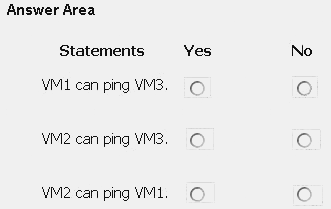
Answer:
Explanation: Box 1: Yes
Vnet1 and Vnet3 are peers. Box 2: Yes
Vnet2 and Vnet3 are peers. Box 3: No
Peering connections are non-transitive.
References: https://docs.microsoft.com/en-us/azure/architecture/reference-architectures/hybridnetworking/ hub-spoke
NEW QUESTION 8
HOT SPOT
Your company has offices in New York and Los Angeles.
You have an Azure subscription that contains an Azure virtual network named VNet1. Each office has a site-to-site VPN connection to VNet1.
Each network uses the address spaces shown in the following table.
You need to ensure that all Internet-bound traffic from VNet1 is routed through the New York office. What should you do? To answer, select the appropriate options in the answer area.
NOTE: Each correct selection is worth one point.
Answer:
Explanation: Incorrect Answers:
Not: New-AzureRmVirtualNetworkGatewayConnection
This command creates the Site-to-Site VPN connection between the virtual network gateway and the on-prem VPN device. We already have Site-to-Site VPN connections.
Box 2: 192.168.0.0/20
Specify the VNET1 address. References:
https://docs.microsoft.com/en-us/powershell/module/azurerm.network/setazurermvirtualnetworkgatewaydefaultsite
NEW QUESTION 9
HOT SPOT
You have an Azure subscription named Subscription1. Subscription1 contains the resources in the following table.
VNet1 is in RG1. VNet2 is in RG2. There is no connectivity between VNet1 and Vnet2.
An administrator named Admin1 creates an Azure virtual machine named VM1 in RG1. VM1 uses a disk named Disk1 and connects to VNet1. Admin1 then installs a custom application in VM1.
You need to move the custom application to Vnet2. The solution must minimize administrative effort.
Which two actions should you perform? To answer, select the appropriate options in the answer area.
NOTE: Each correct selection is worth one point.
Answer:
Explanation: You can move a VM and its associated resources to another resource group using the portal. References: https://docs.microsoft.com/en-us/azure/virtual-machines/windows/move-vm
NEW QUESTION 10
Note: This question is part of a series of questions that present the same scenario. Each question in the series contains a unique solution that might meet the stated goals. Some question sets might have more than one correct solution, while others might not have a correct solution.
After you answer a question in this section, you will NOT be able to return to it As a result, these questions will not appear in the review screen.
You have an Azure Active Directory (Azure AD) tenant named Adatum and an Azure Subscript contains a resource group named Dev.d Subscription1. Adatum contains a group named Developers. Subscription!
You need to provide the Developers group with the ability to create Azure logic apps in the; Dev, resource group.
Solution: On Dev, you assign the Logic App Contributor role to the Developers group. Does this meet the goal?
Answer: A
Explanation: The Logic App Contributor role lets you manage logic app, but not access to them. It provides access to view, edit, and update a logic app.
References:
https://docs.microsoft.com/en-us/azure/role-based-access-control/built-in-roles https://docs.microsoft.com/en-us/azure/logic-apps/logic-apps-securing-a-logic-app
NEW QUESTION 11
You need to recommend a solution to automate the configuration for the finance department users. The solution must meet the technical requirements.
What should you include in the recommended?
Answer: D
Explanation: Scenario: Ensure Azure Multi-Factor Authentication (MFA) for the users in the finance department only.
The recommendation is to use conditional access policies that can then be targeted to groups of users, specific applications, or other conditions.
References:
https://docs.microsoft.com/en-us/azure/active-directory/authentication/howto-mfa-userstates
NEW QUESTION 12
You have an Azure subscription that contains an Azure file share.
You have an on-premises server named Server1 that runs Windows Server 2021. You plan to set up Azure File Sync between Server1 and the Azure file share. You need to prepare the subscription for the planned Azure File Sync.
Which two actions should you perform in the Azure subscription? To answer, drag the appropriate actions to the correct targets. Each action may be used once, more than once, or not at all. You may need to drag the split bar between panes or scroll to view content.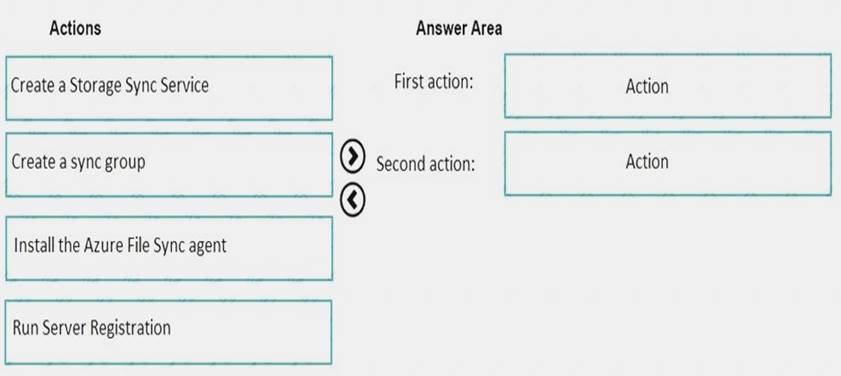
Answer:
Explanation: First action: Create a Storage Sync Service
The deployment of Azure File Sync starts with placing a Storage Sync Service resource into a resource group of your selected subscription.
Second action: Run Server Registration
Registering your Windows Server with a Storage Sync Service establishes a trust relationship between your server (or cluster) and the Storage Sync Service. A server can only be registered to one Storage Sync Service and can sync with other servers and Azure file shares associated with the same Storage Sync Service.
The Server Registration UI should open automatically after installation of the Azure File Sync agent.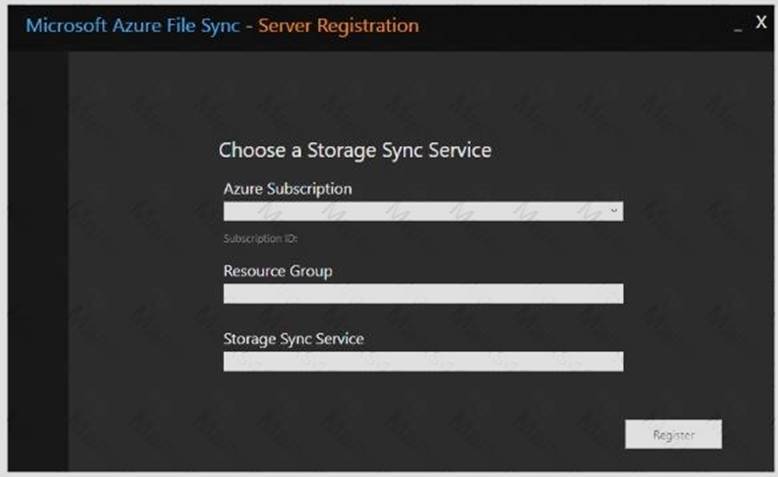
NEW QUESTION 13
You have two Azure virtual networks named VNet1 and VNet2. VNet1 contains an Azure virtual
machine named VM1. VNet2 contains an Azure virtual machine named VM2. VM1 hosts a frontend application that connects to VM2 to retrieve data. Users report that the frontend application is slower than usual.
You need to view the average round-trip time (RTT) of the packets from VM1 to VM2. Which Azure Network Watcher feature should you use?
Answer: D
Explanation: The Connection Monitor feature in Azure Network Watcher is now generally available in all public regions. Connection Monitor provides you RTT values on a per-minute granularity. You can monitor a direct TCP connection from a virtual machine to a virtual machine, FQDN, URI, or IPv4 address. References:
https://azure.microsoft.com/en-us/updates/general-availability-azure-network-watcher-connectionmonitor- in-all-public-regions/
NEW QUESTION 14
DRAG DROP
You have an Azure subscription that contains an Azure virtual machine named VM1. VM1 runs Windows Server 2021 and is part of an availability set.
VM1 has virtual machine-level backup enabled. VM1 is deleted.
You need to restore VM1 from the backup. VM1 must be part of the availability set.
Which three actions should you perform in sequence? To answer, move the appropriate actions from the list of actions to the answer area and arrange them in the correct order.
Answer:
Explanation: 
NEW QUESTION 15
You have an Azure subscription that contains three virtual networks named VNet1, VNet2, VNet3.
VNet2 contains a virtual appliance named VM2 that operates as a router.
You are configuring the virtual networks in a hub and spoke topology that uses VNet2 as the hub network.
You plan to configure peering between VNet1 and VNet2 and between VNet2 and VNet3. You need to provide connectivity between VNet1 and VNet3 through VNet2.
Which two configurations should you perform? Each correct answer presents part of the solution. NOTE: Each correct selection is worth one point.
Answer: BE
Explanation: Allow gateway transit: Check this box if you have a virtual network gateway attached to this virtual network and want to allow traffic from the peered virtual network to flow through the gateway. The peered virtual network must have the Use remote gateways checkbox checked when setting up the peering from the other virtual network to this virtual network.
References:
https://docs.microsoft.com/en-us/azure/virtual-network/virtual-network-managepeering# requirements-and-constraints
NEW QUESTION 16
HOT SPOT
You have an Azure subscription named Subscrption1 that is associated to an Azure Active Directory (Azure AD) tenant named AAD1.
Subscription1 contains the objects in the following table:
You plan to create a single backup policy for Vault1. To answer, select the appropriate options in the answer area.
NOTE: Each correct selection is worth one point.
Answer:
Explanation: Box 1: RG1 only Box 2: 99 years
With the latest update to Azure Backup, customers can retain their data for up to 99 years in Azure. Note: A backup policy defines a matrix of when the data snapshots are taken, and how long those snapshots are retained.
The backup policy interface looks like this:
References: https://docs.microsoft.com/en-us/azure/backup/backup-azure-vms-first-lookarm# defining-a-backup-policy
https://blogs.microsoft.com/firehose/2015/02/16/february-update-to-azure-backup-includes-dataretention- up-to-99-years-offline-backup-and-more/
NEW QUESTION 17
You have a public load balancer that balancer ports 80 and 443 across three virtual machines. You need to direct all the Remote Desktop protocol (RDP) to VM3 only.
What should you configure?
Answer: A
Explanation: To port forward traffic to a specific port on specific VMs use an inbound network address translation (NAT) rule.
Incorrect Answers:
B: Load-balancing rule to distribute traffic that arrives at frontend to backend pool instances. References:
https://docs.microsoft.com/en-us/azure/load-balancer/load-balancer-overview
NEW QUESTION 18
You have an Azure App Service plan that hosts an Azure App Service named App1.
You configure one production slot and four staging slots for App1.
You need to allocate 10 percent of the traffic to each staging slot and 60 percent of the traffic to the production slot.
What should you add to Appl1?
Answer: A
Explanation: Besides swapping, deployment slots offer another killer feature: testing in production. Just like the name suggests, using this, you can actually test in production. This means that you can route a specific percentage of user traffic to one or more of your deployment slots.
Example: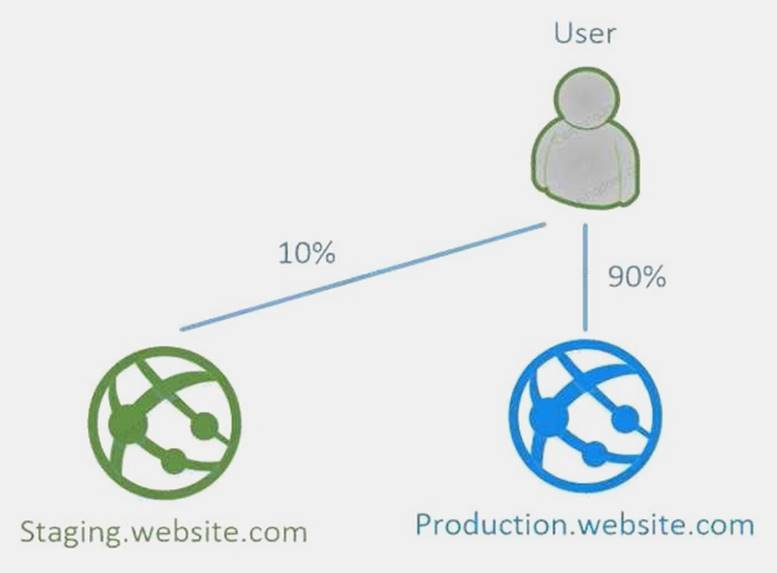
References:
https://stackify.com/azure-deployment-slots/
NEW QUESTION 19
HOT SPOT
Your network contains an Active Directory domain named adatum.com and an Azure Active Directory (Azure AD) tenant named adatum.onmicrosoft.com.
Adatum.com contains the user accounts in the following table.
Adatum.onmicrosoft.com contains the user accounts in the following table.
You need to implement Azure AD Connect. The solution must follow the principle of least privilege. Which user accounts should you use? To answer, select the appropriate options in the answer area. NOTE: Each correct selection is worth one point.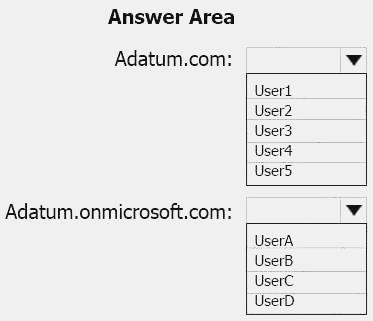
Answer:
Explanation: Box 1: User5
In Express settings, the installation wizard asks for the following: AD DS Enterprise Administrator credentials
Azure AD Global Administrator credentials
The AD DS Enterprise Admin account is used to configure your on-premises Active Directory. These credentials are only used during the installation and are not used after the installation has
completed. The Enterprise Admin, not the Domain Admin should make sure the permissions in Active Directory can be set in all domains.
Box 2: UserA
Azure AD Global Admin credentials credentials are only used during the installation and are not used after the installation has completed. It is used to create the Azure AD Connector account used for synchronizing changes to Azure AD. The account also enables sync as a feature in Azure AD. References: https://docs.microsoft.com/en-us/azure/active-directory/connect/active-directoryaadconnect- accounts-permissions
NEW QUESTION 20
SIMULATION
Click to expand each objective. To connect to the Azure portal, type https://portal.azure.com in the browser address bar.

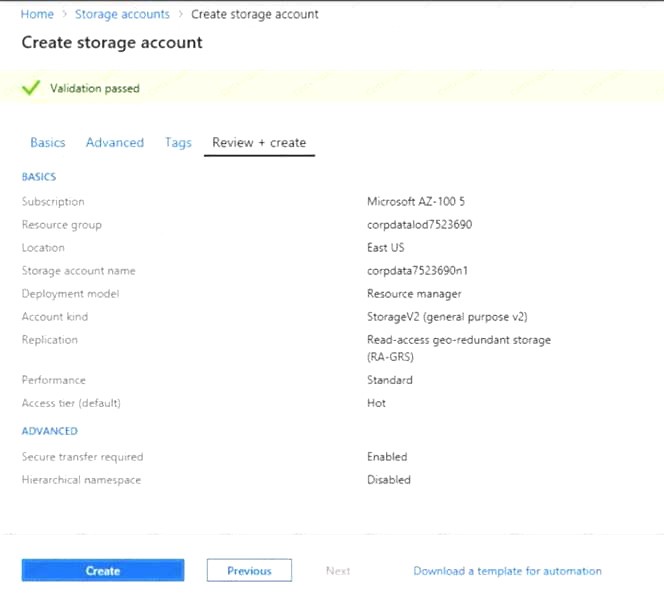
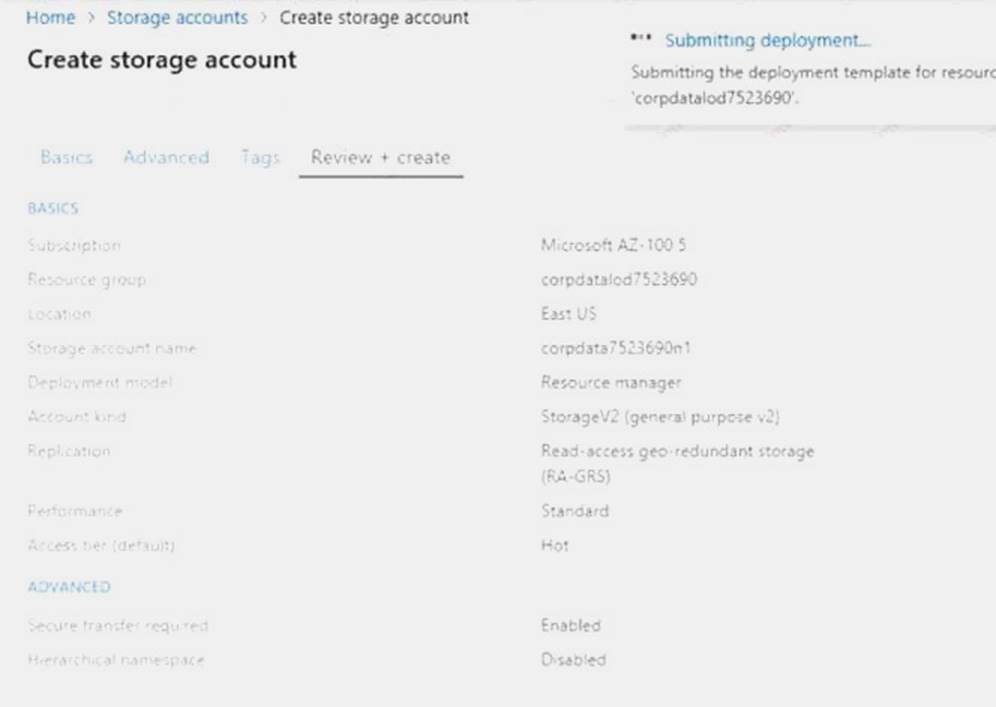

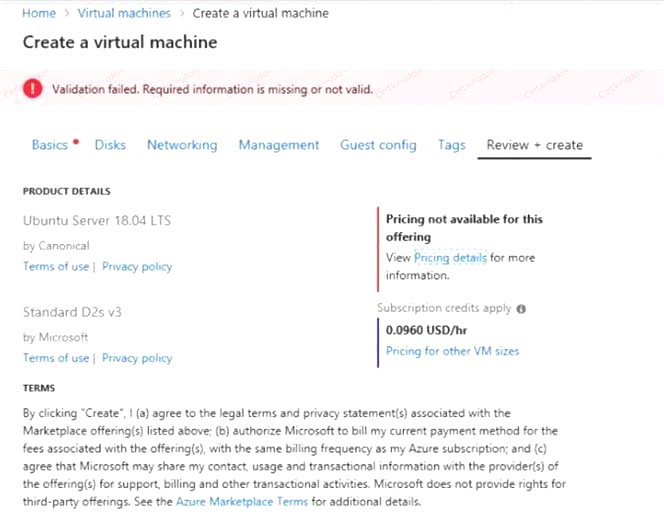
When you are finished performing all the tasks, click the ‘Next’ button.
Note that you cannot return to the lab once you click the ‘Next’ button. Scoring occur in the background while you complete the rest of the exam.
Overview
The following section of the exam is a lab. In this section, you will perform a set of tasks in a live environment. While most functionality will be available to you as it would be in a live environment, some functionality (e.g., copy and paste, ability to navigate to external websites) will not be possible by design. Scoring is based on the outcome of performing the tasks stated in the lab. In other words, it doesn’t matter how you accomplish the task, if you successfully perform it, you will earn credit for that task.
Labs are not timed separately, and this exam may have more than one lab that you must complete. You can use as much time as you would like to complete each lab. But, you should manage your time appropriately to ensure that you are able to complete the lab(s) and all other sections of the exam in the time provided.
Please note that once you submit your work by clicking the Next button within a lab, you will NOT be able to return to the lab.
To start the lab
You may start the lab by clicking the Next button.
You plan to create several virtual machines in different availability zones, and then to configure the virtual machines for load balanced connections from the Internet.
You need to create an IP address resource named ip1006 to support the planned load balancing solution. The solution must minimize costs.
What should you do from the Azure portal?
Answer:
Explanation: We should create a public IP address.
At the top, left corner of the portal, select + Create a resource.
Enter public ip address in the Search the Marketplace box. When Public IP address appears in the search results, select it.
Under Public IP address, select Create.
Enter, or select values for the following settings, under Create public IP address, then select Create: Name: ip1006
SKU: Basic SKU IP Version: IPv6
IP address assignment: Dynamic Subscription: Select appropriate Resource group: Select appropriate
References: https://docs.microsoft.com/en-us/azure/virtual-network/virtual-network-public-ipaddress
100% Valid and Newest Version AZ-102 Questions & Answers shared by Certleader, Get Full Dumps HERE: https://www.certleader.com/AZ-102-dumps.html (New 195 Q&As)